__ __ __ __ __
__ __ __ __ __
__ __ __ __ __
__
In
honor of the premiere of Godzilla
2000, marking the Big Guy's return to
the American movie-plexes after a
fifteen-year slumber -- with
no Matthew Broderick in sight (and can we
all get an amen on that?) -- I finally
decided it was high time to tackle his
debut film, both of them, by taking a look
at the original Japanese version, Gojira,
and the Americanized version, Godzilla:
King of the Monsters: two movies which
share a lot of the same footage, yes, but
are two completely different films.
__ __ __ __ __
__ __ __ __ __
__ __ __ __ __
__
Gojira
begins in darkness. Then, slowly, as the pomp
and circumstance of Akira Ifukube’s
familiar "March of the
Monsters" swells over the opening
credits, it's infused with the
footfalls of something monstrous, punctuated by the most recognizable roar
in all monsterdom. (The
roar was also Ifukube’s creation, made
by rubbing a rubber glove across a
stand-up bass' strings.) When said credits expire, we open at sea with the
crew the Eiko-maru as they lazily lounge
around the deck, seemingly without a care
in the world -- he typed ominously
... When suddenly, the ocean around them
begins to glow, then boil and churn until
a destructive wave of fire crashes over
the freighter, engulfing it completely.
And all of this happened so fast the ship
barely got off a distress signal before it
exploded.
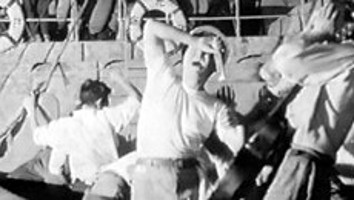
Since
the Eiko-maru was part of the
Southern Sea Shipping line, the owners
call in Ogata (Akira
Takarada), their salvage expert.
But Ogata must first break his date with
Emiko Yamane (Momoko Kouchi),
which he does, before reporting to work. Finding the
offices jammed-packed with relatives
wanting to know the fate of those on
board, Ogata reassures them all a rescue
ship has already been dispatched -- and
it's almost to the spot where the Eiko-maru
went down when the second ship mysteriously
explodes, too! More
ships and planes soon follow but only
three survivors are found; and once
they're picked up, to be taken to the
nearest port on Ohto Island, disaster
strikes yet again when the ship
transporting them never makes it, another
victim of these inexplicable maritime
calamities. Some fishermen from Ohto do
find one survivor among the wreckage, half
dead, who claims to have seen a monster.
And once he passes out, a cranky old coot
proclaims that it must be the mythical Gojira,
come alive to eat them all!
A
few days later, when
Hagiwara (Sachio
Sakai), a reporter, comes to Ohto
to interview the lone survivor, no one is
willing to officially comment about the
shipwrecks -- except the old crackpot, who
tells Hagiwara how they used to sacrifice
girls to appease Gojira, but now, a ritual
"Exorcism Ceremony" is all that
remains of this ancient tradition. Later
that night, a
tropical storm whips up and hits the
island hard. But there is a little bit
more than mere thunder and lightning
involved. Something monstrous has come out
of the ocean, and proceeds to trample the fishing
village flat...
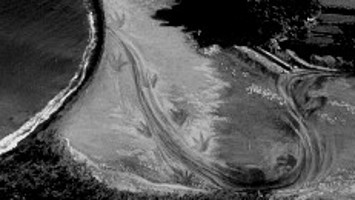
Coming
just nine years after the atom bombs fell
to end World War II, and directed by a man
who witnessed firsthand the destruction
and devastation those bombs caused, these,
and several other factors and influences
converged by chance, circumstance and a
little bad luck to create the film Gojira,
and launch one of the most storied
franchises in all of filmdom.
Back
in 1954, Tomoyuki Tanaka was an up and
coming producer for Toho Motion Picture
Company, Japan's premiere movie studio at
the time. But when his current project, an
Indonesian co-production called Eiko no
Katatani, fell apart over some hassles
concerning the necessary work-permit
visas, Tanaka found himself with a cast,
crew and money to spend but no movie to
expend them on. Now, two years prior, the Japanese cinemas had
been hit with the original King
Kong
for the first time; and when that hit big,
Warner Bros. quickly sent over their new monster movie, The
Beast from 20000 Fathoms,
which also raked it in at the box office,
making it no small wonder then, when on the
flight to Tokyo from Jakarta to break the
bad news to his bosses, Tanaka, while
looking at the vast Pacific below, began wondering what other beasties might be
lurking just below the surface and decided,
then and there, that Japan needed a giant monster of its
own.
Drawing
inspiration from The Lucky Dragon
incident, where a Japanese fishing boat
wandered too close to the Bikini Atoll and
got a massive dose of radiation from the
recent H-Bomb tests, igniting a firestorm
of controversy worldwide, Tanaka's premise
was to have an ancient creature awakened
by these same tests, who would then wreak
havoc on mankind as way for nature to
exact revenge for dabbling to far into its
inherent mysteries. Tanaka's boss, Iwao
Mori, was sold, and Kaitei Niman Mairu
Kara Kita Dai Kaiju, roughly
translated, The Big Monster from 20000
Miles from Beneath the Sea, was given
the green light. Known simply as
"G" -- for giant -- during
production, the legend goes that while
searching for a proper title, Tanaka liked
the sound of a nickname for a burly press
agent, a combination of the words gorira
(gorilla)
and kujira (whale);
it stuck, and the rest is cinematic
history.
|
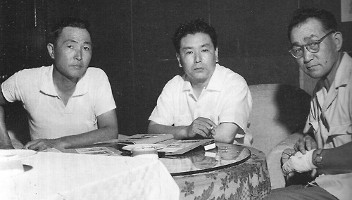
|
|
Ishirô Honda, Tomoyuki Tanaka, Eiji Tsuburaya |
To
direct, Tanaka turned to Akira Kurwasawa's
assistant director,
Ishirô
Honda, who brought a
lot of his own ideas to the project; and
it was his notion to make the monster
indestructible, making it a true
manifestation of the bomb; and he also
added the doomed hero, Serizawa, when he
and Tanaka took over the script after
several drafts failed to capture what they
wanted. For the F/X, when the stop-motion
option was deemed both too expensive and time-consuming,
veteran artist Eiji Tsuburaya was brought
in to oversee the creation of the
monster-suit and the miniatures it was
destined to destroy. Settling on a
combination of a T-Rex and a Stegosaurus,
the heavy and cumbersome costume was worn
by stuntman Haruo Nakajima; and to give
the monster a larger sense of scale, he
had to be filmed at a slower speed and
with double the lights, causing the
overheated actor to faint on several
occasions. The process seems simple enough
on screen, but the effort and coordination
expended to pull these scenes off have
been unjustly maligned and given the short-shrift over
the years and is a terrible insult if
you'd just take the time to look a little
closer at all the details involved.
Pressed
for time and money, the production did run
long and go over budget before it was
eventually completed. But the financial
risk paid off, big time ... 1954 was a huge
year for Toho. Not only was Gojira
released that year, but Kurwasawa's Shichinin
no samurai (Seven
Samurai) and Toshiro Mifune's Mushashi
Miyamoto (The
Master Swordsmen), which would
win the Academy Award for best foreign
picture, were also rolled out to both
critical and box-office success -- so much
so that Toho began to send out feelers
about possible foreign distribution.
Several Stateside film companies took the
bait, but
that's another story for another review.
For now, let's rejoin our film already in
progress...
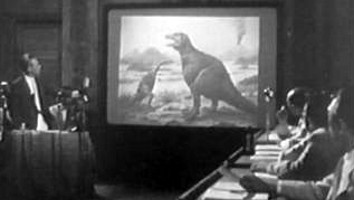
After
the storm lifts, the surviving village
elders are hauled to the mainland to
testify before a government committee.
After relating the mass destruction that
has befallen them to the gathered
politicians, they all state, most
definitely, it was no hurricane that
destroyed their village. Calling in an
expert, a Dr. Kyohei Yamane (Takashi
Shimura), Japan’s
most eminent zoologist -- and also Emiko's
dad --
compares the villager's claims of a
monster to the mystery of the abominable
snowman. Seeing a rare opportunity for
scientific discovery, he volunteers to go
to the island and investigate. When the
expedition sets sail for Ohto, on board
are the
Yamanes, Ogata and Hagiwara. (Brave
souls all, considering what’s happened
to every other boat that’s ventured into
that area.) During the voyage, we
see that Ogata and Emiko are truly in
love. The only problem is, she has
promised to wed another man: a Dr. Daisuke
Serizawa (Akihiko
Airata). We then learn this
engagement happened before the war, but during said war, Serizawa was badly
injured, and after, became somewhat of a
bitter recluse. The two never did get married,
and probably never will, but Emiko
hasn’t officially broken it off with him
yet. Meanwhile, Ogata has his own
problems; he must get consent from the
elder Yamane
-- who arranged his daughter's marriage with Serizawa
-- before they can even think about
getting married ... and so are the Days
of Our Lives.
Upon
arrival, the
expedition finds the coastal village in
ruins and detect traces of radioactivity
everywhere. After a cursory examination,
Yamane believes all the deep impressions
they find are actually the footprints of
some unknown beast. He also finds a
trilobite -- a parasite that was thought
to be extinct. Suddenly, their investigation is
rudely interrupted when a warning bell is
sounded. Hearing the huge footfalls that
probably caused all the damage, they head
for the safety of the hills -- but find they're fleeing
in the wrong direction when Gojira pops
his head up over the crest they're
climbing! After an abrupt about face, most
flee in abject terror but a few brave
souls like Hagiwara manage to snap some
pictures of the monster before it retreats
back into the sea ... Then it's
back to the mainland to
appear before another committee.
Presenting his startling evidence, Yamane
postulates that Gojira is a living
dinosaur that survived over the eons deep
in the ocean. He also believes, due to its
immense radioactivity, the recent hydrogen
bomb
tests are responsible for driving it to
the surface. This wild hypothesis
triggers a
real nasty argument between two officials
on whether to inform the public of
Gojira’s existence or to keep it a
secret. (We’ve
got to close the beaches!)
Amazingly, the politicians decide to go
public, close down all major shipping
lanes, and begin concentrating on finding
a way to kill the monster as soon as
possible.
Starting
with the most direct approach first, an armada
of "Anti-Gojira" frigates are
dispatched; and as they depth-charge the
heck out of the ocean around Ohto, we get several
different viewpoints from several
different people over what is the best
course of action on dealing with the
threat: on a passenger train, John and
Jane Doe argue about the monster, where Jane
states she didn’t survive Nagasaki
just to be eaten by Gojira; Yamane, on the
other hand, thinks they should save Gojira
for scientific study; and Hagiwara
believes the monster should be destroyed
before it can cause any more damage.
Almost on cue, Gojira surfaces in Tokyo
harbor, scares the hell out of some cruise ship
passengers, but doesn’t attack; he just
sniffs around a bit, and then submerges
back into the water.
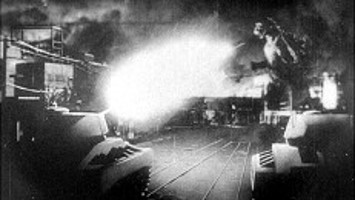
With
the direct approach not really working,
the government asks Yamane if he can think
of anything that can kill Gojira. Alas,
the doctor fears the monster has
absorbed so much radiation that it's
virtually indestructible. He also still
firmly believes they should save and
study this one of a kind creature. Meanwhile,
Hagiwara
receives a tip that a Dr. Serizawa has
made a major breakthrough in a weapon to fight
off Gojira. Asked to go with him for the
interview, Emiko agrees and also promises
Ogata that she will finally tell Serizawa about
them and break off their long
engagement. But Serizawa denies the weapon
rumors. In fact: he won’t talk about his
research at all. Frustrated, Hagiwara soon
leaves, but he should have stuck around.
Seems Serizawa does have a secret
discovery, and he has decided to show
it to Emiko. Taking her to his basement
lab, he puts a small dose of a chemical
powder into an aquarium, teeming with
fish. He then throws an electrical charge
into the water, and as Emiko watches the
violent reaction, she soon recoils in horror and
quickly turns
away. (What
happened? We don’t know. Yet.)
Perhaps regretting his decision, Serizawa
swears her to secrecy.
When
Gojira surfaces again, this time, the
monster comes ashore and tries to eat a
train. Finding this unappetizing, he stomps
around a bit more, smashing several
districts before returning to the sea.
With things rapidly escalating, an
international task-force is assembled to
combat the Gojira threat. But the best
they can come up with is to evacuate the
coast and put up a huge electrical fence,
hoping it will keep the monster out.
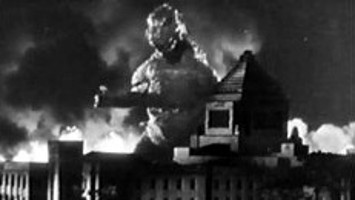
While
all of this implemented, Yamane's foul
mood only worsens over these developments;
and Ogata makes the mistake of picking
that exact moment to ask permission to marry
Emiko. Instead, they argue about Gojira,
and since Ogata thinks the monster should
be destroyed, an enraged Yamane kicks him
out. (Oops.)
And before
Ogata can try to apologize, Gojira attacks
again and makes quick work of the electric
fence. Like the ancient dragons of old,
the beast uses his fiery atomic blasts to
set the whole city ablaze. And this time,
he sticks around for a while, stomping and
crushing the things that he doesn’t set
on fire, cutting a wide swath of
destruction until the Japanese Air Force
drives him off. Yes,
you read that right -- the military
managed to drive the monster away.
The
aftermath of Gojira’s rampage is immense
and those not killed in the initial
assault are poisoned by radiation. Most of
them terminally. At the
hospital, Emiko volunteers to help the
wounded, and is so shaken by all the
suffering, she confesses Serizawa’s
secret to Ogata...
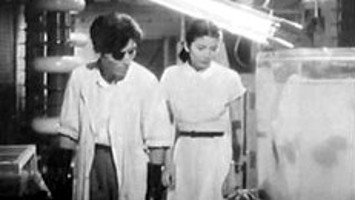
We
flashback to Serizawa’s lab, where
Emiko watches in
horror as the water in the
aquarium bubbles and boils furiously until
all the fish inside are vaporized, leaving
only their skeletal remains --
but then they quickly dissolve, too! With
that, Serizawa reveals how his research led to
the discovery of a powerful substance that
liquefies oxygen. Swearing
his research was only for the
expansion of knowledge (-- sure,
that’s what they all say), the
end result was the deadly "Oxygen
Destroyer." Terrified of this lethal discovery, Serizawa believes that
if given time, a beneficial use for it can
be found. And so far, he’s the only one
who knows how to create it. And Emiko, so
far, is the only one else who knows about
it -- until she blabs to Ogata...
Together,
the couple begs Serizawa to use this
invention against Gojira, but he adamantly
refuses to let his deadly creation be
revealed to the world. And now, with the
secret out, Serizawa begins to destroy his
notes and records. When Ogata tries to
stop this, they fight until Emiko separates
them, and then rushes to the battered
Ogata’s aid. Seeing
there is something between them and that
he's out of the picture, Serizawa goes
into a big speech about why he can’t use
the Oxygen Destroyer. (That I'll go
into greater detail later.) But
then they overhear a
televised national prayer for deliverance
given by the children of Japan, and the
children's desperate cry for help finally sways
Serizawa. He will use the Oxygen Destroyer
-- but just this once, and only once, --
and then proceeds to finish destroying all
of his notes to guarantee this claim.
Using
Geiger counters, the Navy determines
Gojira’s location -- the monster is
sleeping at the bottom of the Tokyo Bay.
Soon enough, Ogata's salvage boat floats
directly above him. Since there's only one
Oxygen Destroyer, Serizawa demands to go
down with Ogata; and since he's the only
one who knows how to trigger it properly,
Ogata begrudgingly agrees and they both
suit up. When
they reach the bottom and find the
slumbering giant, Ogata gives the signal
to haul them up. And he’s halfway home before realizing that Serizawa is still at
the bottom, where he activates the Oxygen
Destroyer, which reacts violently with
water. After Ogata surfaces, he orders the
others to pull Serizawa up. Calling to him
over the radio, as the others plead with
him to surface, Serizawa tells Emiko to be
happy, and then cuts his tow-line and
air-hose, guaranteeing his invention
will never be used for evil intent and its
secrets will die with him.
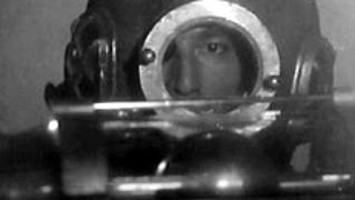
Along
with Serizawa, Gojira is consumed in the
reaction: the monster surfaces briefly,
and gives off one final mournful roar. But
even as his skeletonized remains hit the
bottom and vaporize, Yamane
warns there are probably other
Gojira’s lurking in the ocean, and with
all the nuclear bomb tests going on, it
won’t be long until another one
surfaces.
The
End
I’ve
been a Godzilla
fanatic for over twenty-five years, and
I’m kind of ashamed to admit this, but
it wasn’t until late last year
(--
for the record, 1999 --)
that I finally tracked down and watched
the original Japanese version,
Gojira.
Now, the main difference between the two
versions of the film is
that the love triangle between Emiko,
Ogata and odd-man out Serizawa is more
pronounced in this version. And there's
also the subplot of Dr. Yamane wanting to
study the creature, instead of destroying
it, that is completely
absent from Godzilla:
King of the Monsters.
And of course, Raymond Burr is gone, and
seeing the original in its original
sequence was a tad disjointing after
having seen the Americanized version so
many times. You see, when it was imported
to the States in 1956, the film was torn
asunder and then spliced back together so
the monster showed up sooner, and the
boring romantic interludes were left on
the edit room floor. Also lost in those
cuts and inserts was the overall somber
tone of the piece and the muddling of it's
message.
It
doesn't take a genius to see the monster
in Gojira
as a metaphor for the horrors of the
nuclear age. And as a viewer, if you
really wanted to, you could probably take
that message, tuck it in your pocket and
go on your merry way, but I think there's
a whole lot more going on than mankind's
imminent self-destruction in this
particular morality play.
To
me, the real villain of the piece is
Serizawa's Oxygen Destroyer, and it's with
this deadly invention where the real
message of the movie can be found. Yes,
that's right: my contention is the Oxygen Destroyer -- not Gojira -- that
is the real monster of this
picture. Look at the evidence: feeling
that he can someday find a productive use
for it to benefit mankind, but until then,
Serizawa is so terrified of his creation
that he keeps it a closely guarded secret.
As it is now, in it’s raw form, the
elements can only be used as a weapon of
mass destruction, making the correlation
between the Oxygen Destroyer and the
atomic bombs used to end World War II a
no-brainer. When scientists and engineers
first started messing around with energy
on the atomic level, atomic fission was
the first big breakthrough. Splitting the
atom released a huge amount of energy,
albeit destructive, and it had a ton of
harmful side-effects like radiation. And
in the deserts of New Mexico, where it's
potential application became all too
terrifyingly real, I think Gojira
makes
the argument that perhaps Oppenheimer and
his crew should have kept it a secret
until it could be successfully harnessed
for non-destructive purposes. History
proves that they didn't, and ever since
the atomic genie was let out of the
bottle, where it has since proliferated,
the world has lived in constant fear of
being reduced to a radioactive cinder. To
steal a phrase from uncle Ben Parker:
"With great power, comes great
responsibility" -- that is the
message that Gojira
brings out to me, loud and clear.
In
the film, Serizawa reinforces this
contention when he states that we are in
the shadows of bombs and missiles, and how
the world is on the brink of Armageddon.
Afraid that his creation will tip the
scales and plunge the world into war --
the final war, he wants no part of it and
is content to sit on the sidelines. But in
the end, after seeing the destruction
Gojira has caused, Serizawa breaks down
and decides to use the Oxygen Destroyer to
prevent any more and to save countless
lives. And it should be noted that the
same cold logic was used to justify the
bombings of Hiroshima and Nagasaki, but
what makes Serizawa different than the
gang at the Manhattan Project -- whose
mess, in a sense, he is cleaning up -- is
that he alone knew the secret of his
creation, and knowing it's horrific
potential, he does the honorable thing by
destroying his notes and committing
suicide so his Oxygen Destroyer could
never be made again. Thus the world will
never have to live in fear of it.
All
told, Gojira
is very somber affair with definite
anti-nuclear feelings, and, unlike its
American counterpart, is more about its
ideas and characters than its title
monster. With
all that said, if you haven't read it
yet, let’s go take a look at
the
Americanized version, and see
what else they left out.
|